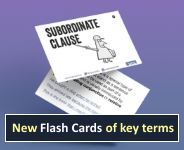Glossary: passive
Explanation
'Passive' is a term applied to a special pattern (or voice) used in a sentence or clause, formed with the auxiliary verb be followed by a verb in the -ed participle form, as in The fence was painted by my sister. Compare this with the more usual active pattern, as in My sister painted the fence. In the active example, the agent or 'doer' of the action (my sister) is expressed as the Subject; but in the passive example, the patient of the action (the fence) becomes the Subject.
The sentence It was eaten by our dog is the passive of Our dog ate it. A passive is recognisable from:
- the past participle form eaten
- the normal Object (it) turned into the Subject
- the normal Subject (our dog) turned into an optional preposition phrase with by as its Head
- the verb be(was), or some other verb such as get.
Contrast active.
A verb is not ‘passive’ just because it has a passive meaning: it must be the passive version of an active verb.
- A visit was arranged by the school.
- Our cat got run over by a bus.
Active versions:
- The school arranged a visit.
- A bus ran over our cat.
Not passive:
- He received a warning. [past tense, active received]
- We had an accident. [past tense, active had]
Englicious contains many resources for English language in schools, but the vast majority of them require you to register and log in first. For more information, see What is Englicious?

